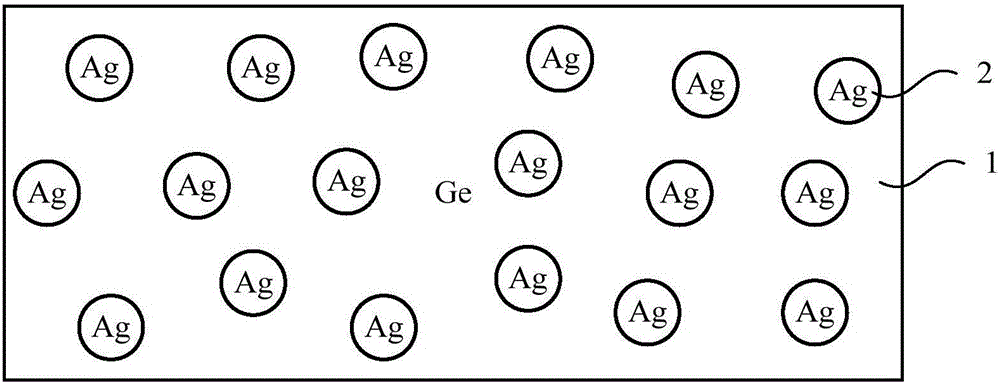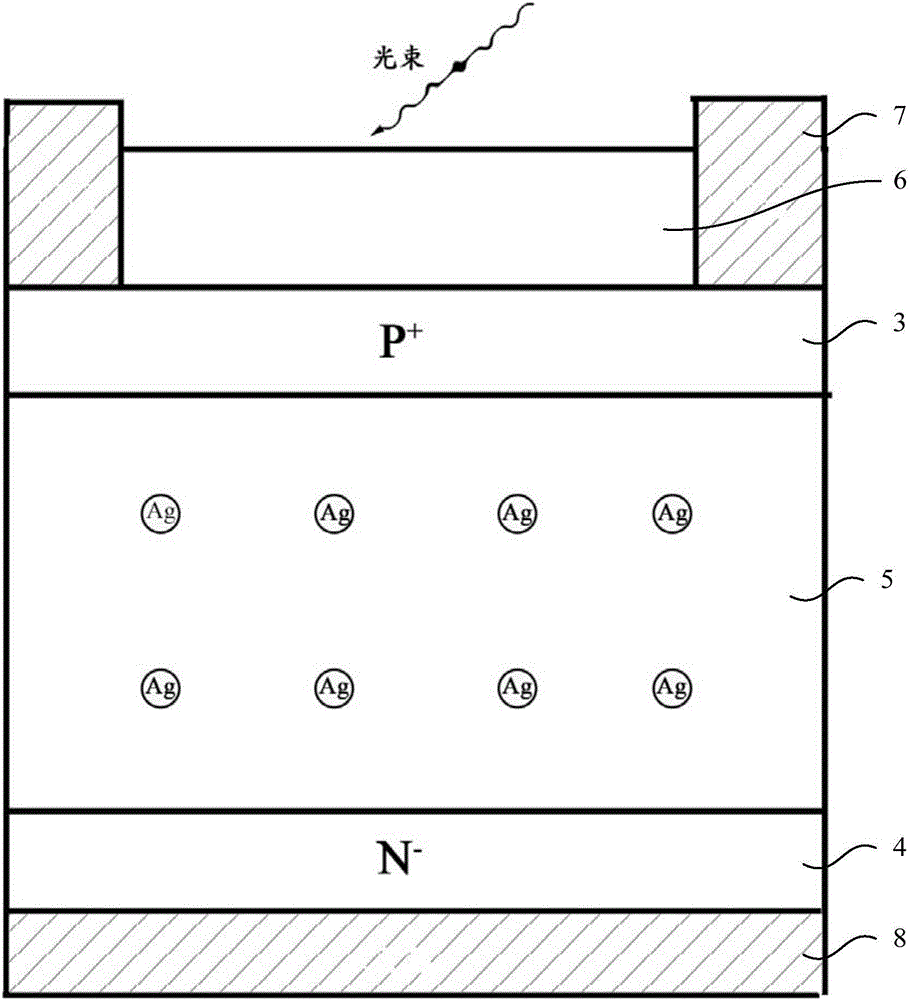Germanium-silver composite and application thereof in photoelectric devices
A technology of composite materials and optoelectronic devices, applied in the field of optoelectronics, can solve problems such as limiting the application of germanium, and achieve the effect of enhancing photoelectric response
- Summary
- Abstract
- Description
- Claims
- Application Information
AI Technical Summary
Problems solved by technology
Method used
Image
Examples
Embodiment 1
[0050] The invention provides a germanium-silver composite material, please refer to figure 1 , which is a simplified structural schematic diagram of the germanium-silver composite material, including intrinsic germanium 1 and silver nanoparticles 2 buried in the intrinsic germanium 1 . In the germanium-silver composite material of the present invention, silver and germanium do not form a bond, but form a composite structure.
[0051] Specifically, intrinsic germanium refers to pure germanium completely free of impurities and lattice defects.
[0052] As an example, the germanium-silver composite material is obtained by implanting silver ions into intrinsic germanium by ion implantation and annealing. Since pure silver ions do not have localized surface plasmon resonance properties, in the present invention, the annealing function is to agglomerate the implanted silver ions into silver nanoparticles, and silver nanoparticles have localized surface plasmon resonance properties...
Embodiment 2
[0057] The present invention also provides an application of a germanium-silver composite material in a photoelectric device. The germanium-silver composite material adopts any germanium-silver composite material described in the first embodiment.
[0058] Specifically, the application is to use the localized surface plasmon resonance enhancement effect of silver nanoparticles to enhance the photoelectric response of germanium in the near-infrared band. Or the application is to use the local surface plasmon resonance enhancement effect of silver nanoparticles and the surface plasmon resonance coupling repulsion between silver nanoparticles to regulate the resonance enhancement peak frequency in the near-infrared band.
[0059] As an example, the application is a germanium-silver composite material as the intrinsic layer material of a PIN photodiode.
[0060] PIN photodiodes are also called PIN junction diodes or PIN diodes, which sandwich a layer of intrinsic semiconductor (In...
Embodiment 3
[0065] This example verifies that the germanium-silver composite material of the present invention can enhance the spectral range of germanium photoelectric response from visible light to near-infrared through theoretical calculation.
[0066] The photoelectric response process of germanium is that photons transfer energy to electrons to become free electrons. Therefore, the photoelectric response characteristics of germanium can be effectively reflected by studying the extinction spectrum of germanium (light absorption and scattering, both processes have energy exchange with electrons). In this embodiment, the finite difference time domain method (FDTD) is used to simulate and calculate the extinction spectrum.
[0067] In order to explore the basic LSPR extinction characteristics of nanoparticles in germanium, a simplified model of silver nanospheres is used for calculation in this embodiment. Numerical simulation model of the present invention such as Figure 3-6 Shown, w...
PUM
| Property | Measurement | Unit |
|---|---|---|
| particle size | aaaaa | aaaaa |
Abstract
Description
Claims
Application Information
 Login to View More
Login to View More - R&D
- Intellectual Property
- Life Sciences
- Materials
- Tech Scout
- Unparalleled Data Quality
- Higher Quality Content
- 60% Fewer Hallucinations
Browse by: Latest US Patents, China's latest patents, Technical Efficacy Thesaurus, Application Domain, Technology Topic, Popular Technical Reports.
© 2025 PatSnap. All rights reserved.Legal|Privacy policy|Modern Slavery Act Transparency Statement|Sitemap|About US| Contact US: help@patsnap.com



